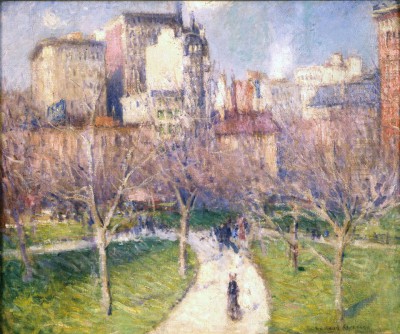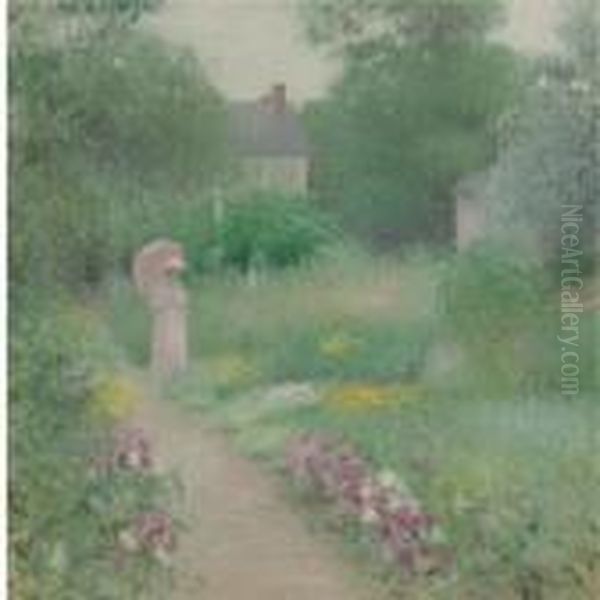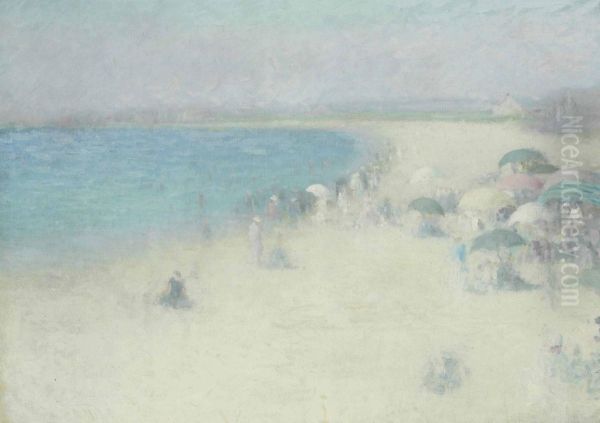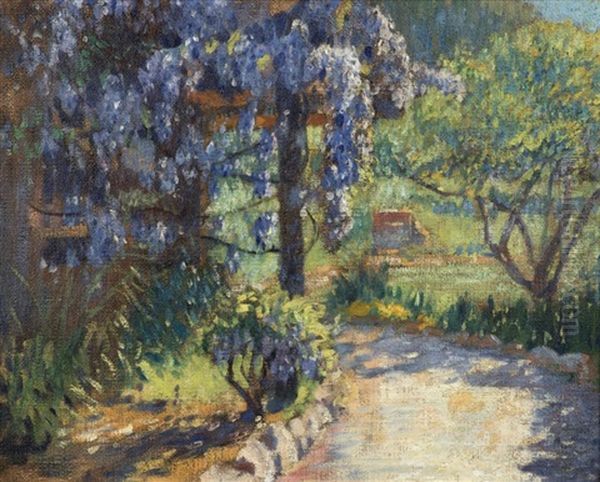
Edmund William Greacen stands as a significant figure in the story of American Impressionism. Born in New York City in 1877 and passing away in 1949, Greacen carved out a distinguished career not only as a painter celebrated for his sensitive handling of light and color but also as an influential educator and organizer within the American art community. His life journey took him from the bustling streets of New York to the heart of the Impressionist movement in France and back, leaving a legacy of beautiful artworks and important institutions.
Early Life and Artistic Awakening
Edmund William Greacen was born into a prosperous New York City family. His parents were immigrants who had arrived from Scotland, establishing a comfortable life for their son. Greacen received a solid education, culminating in his graduation from New York University in 1894. His path initially seemed destined away from the arts; his father harbored hopes of a military career for him.
However, facing the prospect of military service, the young Greacen opted for a different kind of adventure: a world trip. This journey proved pivotal. Exposure to different cultures and sights ignited a passion for art that would define the rest of his life. Rather than joining the army, Greacen chose to enroll in the art school recently established by the prominent American artist William Merritt Chase upon his return. This decision marked the true beginning of his lifelong dedication to painting.
Formative Training Under Chase and European Studies
The decision to study with William Merritt Chase placed Greacen under the tutelage of one of America's most respected painters and teachers. Chase's influence was profound, encouraging a vibrant brushwork and keen observation of light and color, hallmarks that would later define Greacen's own Impressionist style. Chase recognized his student's potential and encouraged him to further his studies abroad.

Following Chase's advice, Greacen embarked on an extended period of study in Europe. His artistic pilgrimage took him through Spain, Belgium, and England, absorbing the diverse artistic traditions of the continent. The most significant part of his European sojourn, however, was his time spent in France. It was here, particularly in the village of Giverny, that Greacen would immerse himself in the very atmosphere that had nurtured the Impressionist movement.
The Giverny Experience and Impressionist Influence
Greacen's time in Giverny was transformative. He lived there for a period, becoming part of the circle of American artists drawn to the village famous as the home of Claude Monet, the titan of French Impressionism. Greacen had the invaluable opportunity to associate with Monet's family, absorbing the principles of Impressionism firsthand. While the provided texts don't explicitly state he studied directly with Monet, the proximity and immersion in the Giverny environment deeply shaped his artistic vision.
The influence of French masters like Monet, and potentially others like Pierre-Auguste Renoir whose work emphasized light and atmosphere, is evident in Greacen's subsequent paintings. He adopted the Impressionist focus on capturing fleeting moments, the effects of light on surfaces, and the use of broken color to convey vibrancy and atmosphere. His time in Giverny solidified his commitment to the Impressionist aesthetic, which he would adapt and interpret through an American lens upon his return.
Development of an American Impressionist Style
Returning to the United States, Greacen established himself as a key figure among the American Impressionists. His style, while rooted in French techniques learned abroad, developed its own distinct characteristics. He became particularly known for his subtle and sophisticated color palette. Critics and viewers noted his masterful use of nuanced tones, especially soft greens, delicate violets, blues, and grays, often combined to create harmonious and evocative atmospheric effects.
Greacen possessed a remarkable sensitivity to light. He excelled at capturing specific conditions – the gentle haze of early morning, the warm glow of a summer afternoon, or the tranquil light of twilight. His brushwork was often delicate yet confident, building forms through color and light rather than strict linear definition. This approach lent his paintings a sense of immediacy and poetic charm, whether depicting landscapes, figures, or intimate garden scenes.
Subject Matter and Favored Locales

Greacen's subject matter primarily revolved around landscapes, garden scenes, floral studies, and portraits. He found particular inspiration in the scenery of the American Northeast. His canvases often featured views from the Old Lyme Art Colony in Connecticut, where he became an active member, as well as landscapes from Short Hills, New Jersey, and Garden City, New York. He had a special affinity for garden scenes, likely stemming from his time in Giverny, capturing the interplay of flowers, foliage, and light.
His cityscapes offered a different perspective, capturing the urban environment with the same attention to light and atmosphere. Portraits also formed part of his oeuvre, demonstrating his skill in capturing likeness and personality through an Impressionist lens. Throughout his active painting years, roughly spanning from 1905 to 1935, Greacen consistently applied his refined Impressionist technique across these varied subjects.
Representative Works
Several paintings stand out as representative of Edmund William Greacen's artistic achievements. In Miss Florence's Garden exemplifies his connection to the Old Lyme Art Colony and his skill in depicting vibrant, sun-dappled garden scenes, a subject beloved by many American Impressionists. The painting likely captures the famous garden of Florence Griswold, whose boarding house was the center of the Old Lyme colony.
The Beach at Watch Hill showcases his ability to render coastal landscapes, capturing the unique light and atmosphere of the shoreline. Works like Boxwood Manor (also referred to as Boxwood House in some sources) further demonstrate his interest in gardens and estates, possibly reflecting his time in Giverny or similar settings in the US. An earlier work, the portrait L'Elégante au Chapeau (1907), highlights his skill in figure painting, imbued with the elegance and light touch characteristic of his style. These works collectively illustrate his mastery of color, light, and Impressionist technique.
The Old Lyme Art Colony Connection
Greacen's involvement with the Old Lyme Art Colony in Connecticut was significant. Situated around Florence Griswold's boarding house, Old Lyme became one of the most important centers for American Impressionism in the early 20th century. Greacen was a prominent member of this artistic community, painting alongside other notable artists who were drawn to the picturesque landscape and collegial atmosphere.
Fellow artists associated with the Old Lyme colony during its Impressionist phase included figures like Childe Hassam, Willard Metcalf, Walter Griffin, William Chadwick, Edward Simmons, and Everett Warner. Greacen's participation placed him firmly within this influential group, contributing to the development and popularization of American Impressionism. He even established his own studio there in his later years, cementing his connection to the area.
A Leader in the Art World: Grand Central Galleries

Beyond his personal artistic output, Greacen played a crucial role in shaping the New York art world through his organizational efforts. Recognizing the need for artists to have reliable venues for exhibiting and selling their work, he collaborated with the renowned portraitist John Singer Sargent and the businessman-artist Walter Leighton Clark.
Together, this trio co-founded the Grand Central Art Galleries in New York City in 1922. Located within Grand Central Terminal, this ambitious project aimed to provide a non-profit exhibition space run by artists for artists. It offered members a platform to showcase their work consistently to a wide public. Greacen's involvement in establishing this major institution highlights his commitment to supporting fellow artists and promoting American art. He was also involved in the precursor organization, the "Association of Painters and Sculptors," alongside Sargent and Clark.
Educator and Founder: Grand Central School of Art
Greacen's dedication to the arts extended deeply into education. Concurrent with the founding of the Galleries, he was instrumental in establishing the Grand Central School of Art, also located initially within Grand Central Terminal. This school aimed to provide high-quality art instruction based on traditional principles, perhaps as a counterpoint to emerging modernist trends.
Greacen didn't just help found the school; he served as its president and director for over two decades. His leadership shaped the institution, guiding its curriculum and fostering the talents of numerous students. This long tenure underscores his commitment to arts education and his belief in passing on artistic knowledge and skills. His role as an educator complemented his work as a painter and organizer, making him a multifaceted contributor to American art.
Writings and Artistic Philosophy
Further evidence of Greacen's thoughtful approach to art can be found in his writings. He authored an article titled "The Origins of Landscape Painting," suggesting an intellectual engagement with art history and theory. While it remained unpublished, he also penned a manuscript titled "Logic in Drawing," indicating a methodical and perhaps philosophical approach to the fundamentals of artistic practice.
These writings, though not widely disseminated, point to an artist who reflected deeply on his craft and its principles. They suggest a desire to articulate the underpinnings of artistic creation, aligning with his role as an educator dedicated to imparting foundational skills and understanding to his students at the Grand Central School of Art.
Recognition, Awards, and Exhibitions
Greacen's contributions and artistic merit received significant recognition during his lifetime. He was elected an Associate Member of the prestigious National Academy of Design in 1920, a mark of high esteem from his peers. Fifteen years later, in 1935, he was elevated to the status of full Academician (NA), confirming his standing in the American art establishment. Other prominent Impressionists like J. Alden Weir and Frank Weston Benson were also members, placing Greacen within this respected circle.
His work garnered awards, notably the Samuel T. Shaw Prize of ,000 from the Salmagundi Club in 1922, a significant honor at the time. Throughout his career, Greacen exhibited his paintings widely. His work was shown at major institutions like the Pennsylvania Academy of the Fine Arts and the National Academy of Design. He had solo exhibitions at commercial venues like the Macbeth Gallery in New York (a show is noted for 1922, though this gallery also famously showed artists like William Glackens and members of The Eight, including Robert Henri). A posthumous exhibition was held at the Cummer Museum of Art in Jacksonville, Florida, in 1972. His work was also documented in publications like "The Annual Record of Exhibitions."
Later Life, Family, and Lasting Legacy
Greacen's artistic career was briefly interrupted by the First World War, but he returned to his painting and educational activities afterward. He maintained his connection to Old Lyme, Connecticut, in his later years. His family life included his wife, possibly named Ethol Both (or Booth), and their daughter, Nan Greacen Faure, who followed in her father's footsteps and became an artist herself.
Edmund William Greacen passed away in 1949. His legacy endures through his beautiful Impressionist paintings, which are held in the collections of numerous museums, including the Metropolitan Museum of Art in New York, the Pennsylvania Academy of the Fine Arts, the Cummer Museum of Art, and the Florence Griswold Museum in Old Lyme, among others. His influence also persists through the institutions he helped create – the Grand Central Art Galleries and the Grand Central School of Art – which played vital roles in the American art scene for decades.
Conclusion: Artist and Educator
Edmund William Greacen occupies a distinguished place in American art history. He was a gifted painter who skillfully adapted French Impressionist techniques to depict the American landscape and life, known for his refined color sense and mastery of light. His paintings offer a poetic and sensitive vision, capturing the beauty of gardens, coastlines, and quiet moments.
Equally important was his role as an educator and organizer. Through his leadership at the Grand Central School of Art and his co-founding of the Grand Central Art Galleries, he actively worked to support artists and foster traditional artistic skills. Greacen's career demonstrates a profound dedication not only to personal artistic creation but also to the broader health and continuity of the American art community. He remains an important figure for his beautiful canvases and his lasting institutional contributions.